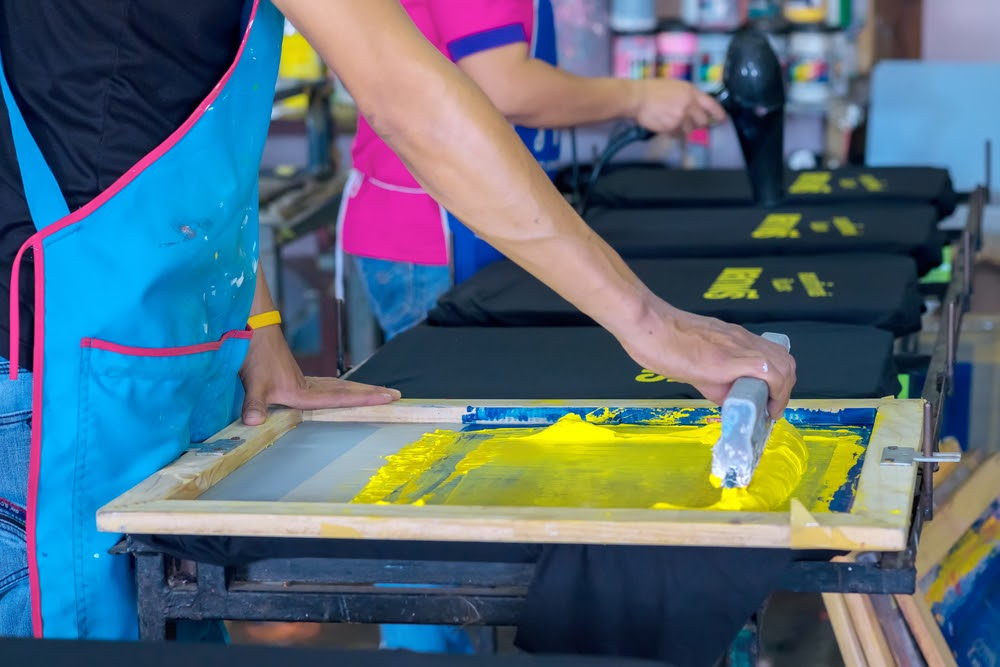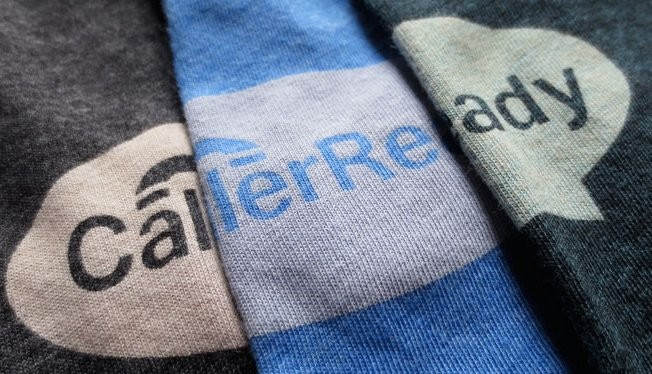Screen printing is not just a technique but an art form that has withstood the test of time. It provides designers and brands with a precise and creative way to express their ideas.
This guide will introduce you to the world of screen printing and help you understand why it remains the preferred method for creating high-quality custom designs.
What is Screen Printing?
Screen printing is a technique that involves using a screen, ink, and squeegee to transfer a design onto a surface, typically fabric.

The process begins with creating a stencil or “screen,” which is then placed over the fabric. Ink is applied to the screen and pushed through the mesh using a squeegee, leaving a printed design on the fabric.
Types of Screen Printing Techniques
Spot Color Printing

Description: Spot color printing is the most traditional form of screen printing. It uses a separate screen for each color in the design, applying one solid, vibrant color at a time.
Best For: Simple designs with few colors, such as logos and text.
CMYK Printing

Description: This technique uses four colors (cyan, magenta, yellow, and black) to create full-color images. By layering these colors in varying proportions, a wide range of colors and realistic designs can be achieved.
Best For: High-detail designs and photographs.
Puff Printing

Description: Puff printing involves mixing special additives with the ink, causing it to expand when heated. This creates a raised, fluffy texture on the fabric.
Best For: Designs that need a 3D effect or playful texture.
Foil Screen Printing

Description: Foil printing applies an adhesive layer on the fabric, which is then covered with metal foil. The result is a shiny, reflective design that stands out.
Best For: High-impact metallic designs and embellishments.
Discharge Printing

Description: Discharge printing removes the dye from the fabric, revealing the natural color of the fibers. New colors can then be applied, or the natural color can be used as part of the design.
Best For: Soft, vintage-style prints on dark fabrics.
Water-Based Screen Printing

Description: This eco-friendly method uses water-based inks that penetrate the fabric, resulting in a soft, breathable print. It has less vibrancy on dark fabrics but provides a smooth, delicate surface.
Best For: Lightweight fabrics and designs that require a soft touch.
Choosing the Right Fabric for Screen Printing
In screen printing, not all fabrics are created equal. The type of fabric you choose will greatly impact the final result of the print.
Fabric Compatibility
Cotton: Cotton is the most commonly used fabric in screen printing due to its smooth surface and absorbency, which allows the ink to adhere well and produce vibrant colors.
Polyester: Polyester fibers are durable, moisture-wicking, and resistant to shrinking.
However, when using screen printing, specialized inks such as plastisol or water-based inks designed for synthetic fabrics are needed to prevent dye migration and ensure proper adhesion.
Cotton-Polyester Blends: Blended fabrics combine the softness of cotton with the durability and moisture-wicking properties of polyester. They strike a balance between comfort and performance.
For the best results, choose high-cotton blends, such as 80/20 or 90/10 cotton blends.
Tri-Blends (Cotton, Polyester, and Rayon): Tri-blend fabrics offer an ultra-soft feel, elasticity, and a vintage appearance.
Due to the multiple intertwined fibers, the ink may not fully penetrate all areas of the fabric, which can lead to a faded or vintage look, making it a great material for shirt prints.
Impact on Design and Feel
The fabric you choose not only affects the appearance of the print but also the overall feel of the garment.
Heavier fabrics like thick cotton result in richer prints, while lighter fabrics like plain knits or modal produce softer, more flexible prints.
Screen Printing Process: Step by Step
Design Preparation
Start by creating a high-resolution digital file of your design, which will be used to create the screen.
For the best results, the design should be created at a resolution of at least 300 DPI and saved in a vector format (such as AI or EPS) to ensure crisp lines and accurate
Creating the Screen
Once the design is ready, it’s time to create the screen. Apply a light-sensitive emulsion to the screen mesh, then place the design on the screen and expose it to light.
The areas exposed to light will harden, while the areas covered by the design will remain soft and can be washed away, leaving a stencil of the design on the screen.
Printing the Design
With the screen prepared, the next step is to set up the printing press. Place the screen on the fabric and apply ink to the top of the screen.
The printer then uses a squeegee to push the ink through the mesh, transferring the design onto the fabric.
Curing and Finishing
After the design is printed, it needs to be cured to solidify the ink and ensure its durability.
This is typically done using a heat press or conveyor dryer, which applies heat to the fabric, bonding the ink to the fibers.
Why Choose Screen Printing?
Vibrant Colors: Screen printing produces rich, vibrant colors that can be more intense and opaque than those created by other printing methods.
Durability: Screen-printed designs are highly durable and resistant to fading, peeling, and cracking, especially when applied with high-quality inks.
Versatility: Screen printing can be used on a variety of fabrics, including cotton, polyester, and more.
Cost-Effective for Large Orders: Although the setup cost for screen printing can be high, once the screens are created, the cost per item decreases significantly with larger quantities.
Special Effects and Finishes: Screen printing allows for the use of special inks and techniques, such as metallic, glitter, puff, and discharge printing, to create unique effects.
Limitations of Screen Printing
Complex Setup Process: Preparing screens and setting up the printing press is a time-consuming process that requires precision.
This makes it less suitable for small orders or designs that require frequent changes.
Limited Color Range: While screen printing excels at solid colors, it is not as effective with gradients and complex color blends.
This makes it less suitable for designs with a wide range of colors.
Detail Limitations: Fine details and small text may be difficult to reproduce accurately with screen printing, especially on textured or uneven surfaces.
Applications of Screen Printing
- T-Shirts: T-shirts are the most common garment for screen printing. The technique is suitable for everything from simple logos and text to complex multi-color designs. It is ideal for creating custom t-shirts for brands, events, sports teams, or promotional items.
- Hoodies and Sweatshirts: Screen printing is used to apply large designs or logos to the front, back, or sleeves of hoodies and sweatshirts. This application is popular in streetwear and athletic apparel brands.
- Athletic Wear: Performance fabrics like polyester can be screen printed with team names, numbers, and logos.
- Bags and Accessories: Tote bags, hats, backpacks, and other accessories often feature screen-printed logos, slogans, or designs. The versatility of screen printing makes it suitable for various materials, including canvas, cotton, and nylon.
Screen Printing Trends and Innovations
Eco-Friendly Inks
As sustainability becomes increasingly important in the fashion industry, many designers and brands are adopting eco-friendly inks for screen printing projects.
These inks are made from natural or water-based materials, reducing their environmental impact.
Eco-friendly inks also offer a softer feel and more breathable prints, making them an excellent choice for comfort-focused apparel.
Hybrid Printing
Hybrid printing combines the benefits of screen printing and digital printing, allowing for more complex designs that traditional screen printing alone cannot achieve.
By combining screen-printed base colors with the fine details of digital printing, designers can create highly detailed and intricate prints that stand out in the market.
Interactive Prints
Interactive prints are an exciting trend that allows consumers to engage with apparel in novel and innovative ways.
For example, heat-sensitive prints that change color with body temperature or touch-activated prints that reveal hidden designs when touched.
These interactive elements add a fun and playful dimension to clothing, making them particularly popular in streetwear and casual fashion.
Bringing Your Vision to Life with Screen Printing
Fashion is all about self-expression. Whether you’re creating simple logos or intricate artwork, screen printing enables you to bring your vision to life with precision and style.
By understanding the different techniques, materials, and processes involved in screen printing, you can make informed decisions that help you achieve the best results.
So, keep experimenting with different techniques, colors, and fabrics, and most importantly, enjoy the process!



